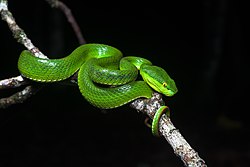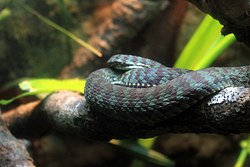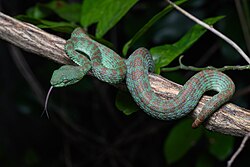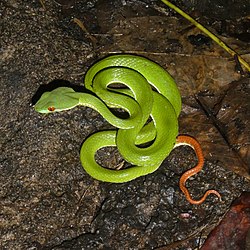| Image | Species [2] | Taxon author [2] | Subsp.* [2] | Common name [5] | Geographic range [1] |
|---|
 | T. albolabris | Gray, 1842 | 0 | white-lipped pit viper | India (Assam), Nicobar Islands, Myanmar, Thailand, Cambodia, Laos, Vietnam, Southern China (Fujian, Hainan, Guangxi, Guangdong), Hong Kong, West Malaysia, Indonesia (Sumatra, Borneo, Sulawesi, Java, Madura, Lombok, Sumbawa, Komodo, Flores, Sumba, Rote, Timor, Kisar, Wetar). |
 | T. andersonii | Theobald, 1868 | 0 | Anderson's pit viper, Andaman pit viper | Andaman Islands, Nicobar Islands. |
| T. arunachalensis | Captain, Deepak, Pandit, Bhatt & Athreya, 2019 | 0 | Arunachal pit viper | India: Arunachal Pradesh |
| T. ayerwadyensis | Chan, Anuar, Sankar, Law, Law, Shivaram, Christian, Mulcahy & Malhotra, 2023 | 0 | Ayerwady pit viper | Myanmar |
| T. calamitas | Vogel, David & Sidik, 2022 | 0 | | Indonesia (Nias Island). |
| T. cantori | Blyth, 1846 | 0 | Cantor's pit viper | India: Nicobar Islands, and possibly the Andaman Islands. |
 | T. cardamomensis | Malhotra, Thorpe, Mrinalini & B. Stuart, 2011 | 0 | Cardamom Mountains green pit viper | Eastern Thailand, Koh Kong Province in Cambodia. |
| T. caudornatus | Chen, Ding, Vogel & S. Shi, 2020 | 0 | ornamental-tailed pit viper | China (Yunnan). |
| T. ciliaris | Idiiatullina, Pawangkhanant, Tawan, Worranuch, Dechochai, Suwannapoom, Nguyen, Chanhome & Poyarkov, 2023 | 0 | limestone eyelash pit viper | Thailand |
| T. cryptographicus | Pawangkhanant, Idiiatullina, Ruangsuwan, Matsukoji, David, Suwannapoom & Poyarkov, 2025 | 0 | Cryptic green pit viper | Thailand |
| T. Cyanolabris | Idiiatullina, Nguyen, Bragin, Pawangkhanant, Le, Vogel, David & Poyarkov, 2024 | 0 | blue lipped green pit viper | Vietnam |
| T. davidi | Chandramouli, P. Campbell & Vogel, 2020. [6] | 0 | | Car Nicobar, India. |
| T. erythrochloris | Pawangkhanant, Idiiatullina, Smits, Dugdale, Pierce, Suwannapoom & Poyarkov, 2025 | 0 | Red barred green pit viper | Thailand |
 | T. erythrurus | Cantor, 1839 | 0 | red-tailed bamboo pit viper | India (Assam and Sikkim), Bangladesh and Myanmar. |
| T. fasciatus | Boulenger, 1896 | 0 | banded pit viper | Indonesia: Djampea Island. |
 | T. flavomaculatus | Gray, 1842 | 2 | Philippine pit viper | Philippine Islands: Agutayan, Batan, Camiguin, Catanduanes, Dinagat, Jolo, Leyte, Luzon, Mindanao, Mindoro, Negros and Polillo. |
 | T. gracilis | Ōshima, 1920 | 0 | Kikushi habu | Central Taiwan. |
 | T. gumprechti | David, Vogel, Pauwels & Vidal, 2002 | 0 | Gumprecht's green pit viper | China (Yunnan), Laos, Thailand, Vietnam. |
| T. gunaleni | Vogel, David & Sidik, 2014 | 0 | Gunalen's pit viper | Sumatra. |
 | T. guoi | Chen, S. Shi, Vogel & Ding, 2020 | 0 | Guo's green pit viper | China, Vietnam, Thailand, Myanmar. |
 | T. hageni | Lidth de Jeude, 1886 | 0 | Hagen's pit viper | Peninsular Thailand, West Malaysia, Singapore and Indonesia (Sumatra and the nearby islands of Bangka, Simalur, Nias, Batu and the Mentawai Islands. |
| T. honsonensis | L. Grismer, Ngo & J. Grismer, 2008 | 0 | Hon Son pit viper | Southern Vietnam. |
 | T. insularis | Kramer, 1977 | 0 | Sunda Island pit viper, white-lipped island pit viper | Indonesia, Timor-Leste |
 | T. kanburiensis | M.A. Smith, 1943 | 0 | Kanburi pit viper | Thailand. |
| T. kirscheyi | Vogel, David & Sidik, 2022 | 0 | Simeulue pit viper | Indonesia (Simeulue Island). |
| T. kraensis | Idiiatullina, Nguyen, Pawangkhanant, Suwannapoom, Chanhome, Nguyen, David, Vogel & Poyarkov, 2024 | 0 | Nicobar Kra isthumus pit viper | India: Thailand. |
 | T. kuiburi | Sumontha, Suntrarachun, Pauwels, Pawangkhanant, Chomngam, Iamwiriyakul & Chanhome, 2021 | 0 | Kui Buri pit viper | Thailand. |
| T. labialis | Steindachner, 1867 | 0 | Nicobar bamboo pit viper | India: Nicobar Islands. |
| T. lanna | Idiiatullina, Nguyen, Pawangkhanant, Suwannapoom, Chanhome, Mirza, David, Vogel & Poyarkov, 2024 | 0 | Nicobar Lanna pit viper | India: Thailand. |
 | T. macrops | Kramer, 1977 | 0 | large-eyed pit viper | Thailand, Cambodia and southern Vietnam. |
 | T. malcolmi | Loveridge, 1938 | 0 | Malcolm's pit viper | Borneo. |
 | T. mayaae | Rathee, Purkayastha, Lalremsanga, Dalal, Biakzuala, Muansanga & Mirza, 2022 [7] | 0 | Maya's pit viper | India: Meghalaya (Ri Bhoi), Mizoram (Champhai), Assam (Guwahati) [8] |
 | T. mcgregori | Taylor, 1919 | 0 | McGregor's pit viper, McGregor's tree viper, Philippine pit viper | Batan Island, Philippines. |
 | T. medoensis | Zhao, 1977 | 0 | Motuo bamboo pit viper | Northern India, northern Myanmar, and China (southeastern Xizang). |
| T. mutabilis | Stoliczka, 1870 | 0 | Central Nicobar pit viper, Central Nicobar bamboo pit viper | Central Nicobar Island. |
 | T. nebularis | Vogel, David & Pauwels, 2004 | 0 | Cameron Highlands pit viper, clouded pit viper | West Malaysia (Cameron Highlands), Thailand. |
| T. phuketensis | Sumontha, Kunya, Pauwels, Nitikul & Punnadee, 2011 [9] | 0 | Phuket pit viper | Thailand: Phuket Island. |
 | T. popeiorum | M.A. Smith, 1937 | 2 | Popes' pit viper | Northern India, Myanmar, Thailand, West Malaysia, Vietnam and Indonesia (Sumatra, the Mentawai Islands of Siberut, Sipora, and North Pagai, and on the island of Borneo). |
 | T. purpureomaculatus | Gray, 1832 | 0 | mangrove pit viper | Bangladesh, Myanmar, Thailand, West Malaysia, Singapore and Indonesia (Sumatra). |
 | T. rubeus | (Malhotra, Thorpe, Mrinalini & L. Stuart, 2011) | 0 | ruby-eyed green pitviper | southern Vietnam and eastern Cambodia |
 | T. sabahi | Regenass & Kramer, 1981 | 0 | Sabah bamboo pit viper, Sabah pit viper | Sabah, Sarawak |
 | T. salazar | Mirza, Bhosale, Phansalkar, Sawant, Gowande & Patel (2020) | 0 | Salazar's pit viper [10] | India: western lowlands of Arunachal Pradesh |
 | T. schultzei | Griffin, 1909 | 0 | Schultze's pit viper | Philippines: Palawan and Balabac. |
 | T. septentrionalis | Kramer, 1977 | 0 | Nepal pit viper, Himalayan white-lipped pit viper | Bangladesh, India, Nepal |
| T. sichuanensis | Guo & Wang, 2011 | 0 | Sichuan pit viper | Sichuan, China |
 | T. stejnegeri | Schmidt, 1925 | 2 | Stejneger's pit viper | India (Assam), and Nepal through Myanmar and Thailand to China (Guangxi, Guangdong, Hainan, Fujian, Zhejiang, Yunnan) and Taiwan. |
 | T. sumatranus T | Raffles, 1822 | 0 | Sumatran pit viper | Southern Thailand, West and East Malaysia (Sabah and Sarawak on Borneo) and Indonesia (Bangka, Billiton, Borneo, Sumatra and the nearby islands of Simalur, Nias, and possibly the Mentawai Islands [Sipora]). |
| T. Tennasserimensis | Idiiatullina, Nguyen, Pawangkhanant, Suwannapoom, Chanhome, Mirza, David, Vogel & Poyarkov, 2024 | 0 | Tennasserim pit viper | Thailand. |
| T. tibetanus | Huang, 1982 | 0 | Tibetan bamboo pit viper | China: Xiang (Tibet) Autonomous Region. |
 | T. truongsonensis | Orlov, Ryabov, Thanh & Cuc, 2004 | 0 | Quang Binh pit viper | Central Vietnam |
| T. uetzi | Vogel, Nguyen, David, 2023 | 0 | Uetz's pit viper | Myanmar. |
 | T. venustus | Vogel, 1991 | 0 | beautiful pit viper, brown-spotted pit viper | Southern Thailand |
 | T. vogeli | David, Vidal & Pauwels, 2001 | 0 | Vogel's pit viper | Cambodia, Laos, Thailand, Vietnam. |
| T. whitteni | Vogel, David & Sidik, 2022 | 0 | Siberut pit viper | Indonesia (Siberut Island). |
| T. yingjiangensis | Chen, Ding, J. Shi & Zhang, 2019 | 0 | | Southwest China |
| T. yunnanensis | Schmidt, 1925 | 0 | Yunnan bamboo pit viper | Southern China |
|



































